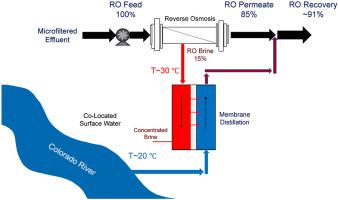Water Research ( IF 11.4 ) Pub Date : 2020-07-03 , DOI: 10.1016/j.watres.2020.116134 Omar Alrehaili 1 , François Perreault 2 , Shahnawaz Sinha 2 , Paul Westerhoff 2

|
Maximizing water recovery and minimizing the volume of RO concentrate (i.e., brine) produced is a growing challenge, especially for inland communities that lack ocean disposal options. In such regions, transitioning towards zero liquid discharge (ZLD) can avoid detrimental impacts associated with salt disposal via regional sewer discharge or deep-well injection. On-site ZLD energy requirements are proportional to the RO brine flowrate. Thus, system-level strategies that reduce RO brine flows will lower ZLD costs while simultaneously increasing the overall water recovery for beneficial reuse in reclamation facilities. We investigated a membrane distillation (MD) system operating without heat exchangers using co-located, cooler source water to treat warmer wastewater RO brine. Using experimentally-quantified MD fluxes based on observed monthly water temperatures of co-located water and RO brine at a facility in central Arizona, and based on the previously reported performance of large-scale MD systems, energy consumption and operating cost were estimated to evaluate the potential capabilities of MD to treat RO brine at full scale facilities. When the RO unit was combined with MD brine treatment, net water recovery increased from 85% to up to 91% while brine volume was reduced by 26%, without any external input of thermal energy or heat exchangers. The additional thermal energy required to achieve RO net water recovery of 95% was calculated to be $1.55–2.13 per 1000 gallon ($0.40 – $0.56 per m3) of RO brine, which is 23% lower compared to a 3rd-stage RO. Overall, this work demonstrates the potential to use local thermal gradients to reduce RO brine volumes, thereby reducing ZLD costs.
中文翻译:

利用盐水和共处一地的水源之间的自然温差,通过膜蒸馏提高反渗透的净水回收率:对大型填海设施的影响。
最大化水的回收率和最小化生产的反渗透浓缩物(即盐水)的数量是一个日益严峻的挑战,对于缺乏海洋处置选择的内陆社区尤其如此。在这样的地区,向零液体排放(ZLD)过渡可以避免与通过区域下水道排放或深井注水进行盐处理相关的有害影响。现场ZLD的能量需求与反渗透盐水的流量成正比。因此,减少RO盐水流量的系统级策略将降低ZLD成本,同时提高总体水回收率,从而有利于回收设施的再利用。我们研究了在没有热交换器的情况下运行的膜蒸馏(MD)系统,该系统使用位于同一地点的较冷水源水来处理较热的废水RO盐水。使用实验量化的MD通量,基于在亚利桑那州中部某设施的同位水和RO盐水的每月观测水温,并基于先前报道的大型MD系统的性能,估计能源消耗和运营成本,以评估MD在满规模设施中处理反渗透盐水的潜在能力。当反渗透装置与MD盐水处理结合使用时,净水回收率从85%增至91%,而盐水体积减少了26%,而无需任何外部热能或热交换器的输入。计算出实现RO净水回收率达到95%所需的额外热能为每1000加仑1.55–2.13美元(每平方米0.40 – 0.56美元)基于先前报道的大型MD系统的性能,估计了能源消耗和运营成本,以评估MD在满规模设施中处理反渗透盐水的潜在能力。当反渗透装置与MD盐水处理结合使用时,净水回收率从85%增至91%,而盐水体积减少了26%,而无需任何外部热能或热交换器的输入。计算出实现RO净水回收率达到95%所需的额外热能为每1000加仑1.55–2.13美元(每平方米0.40 – 0.56美元)基于先前报道的大型MD系统的性能,估计了能源消耗和运营成本,以评估MD在满规模设施中处理反渗透盐水的潜在能力。当反渗透装置与MD盐水处理结合使用时,净水回收率从85%增至91%,而盐水体积减少了26%,而无需任何外部热能或热交换器的输入。计算出实现RO净水回收率达到95%所需的额外热能为每1000加仑1.55–2.13美元(每平方米0.40 – 0.56美元)净水回收率从85%增至91%,而盐水量减少了26%,而无需任何外部热能或热交换器的输入。计算出实现RO净水回收率达到95%所需的额外热能为每1000加仑1.55–2.13美元(每平方米0.40 – 0.56美元)净水回收率从85%增至91%,而盐水量减少了26%,而无需任何外部热能或热交换器的输入。计算出实现RO净水回收率达到95%所需的额外热能为每1000加仑1.55–2.13美元(每平方米0.40 – 0.56美元)3)RO盐水,比第三阶段的RO低23%。总的来说,这项工作证明了使用局部热梯度来减少RO卤水量,从而降低ZLD成本的潜力。











































 京公网安备 11010802027423号
京公网安备 11010802027423号